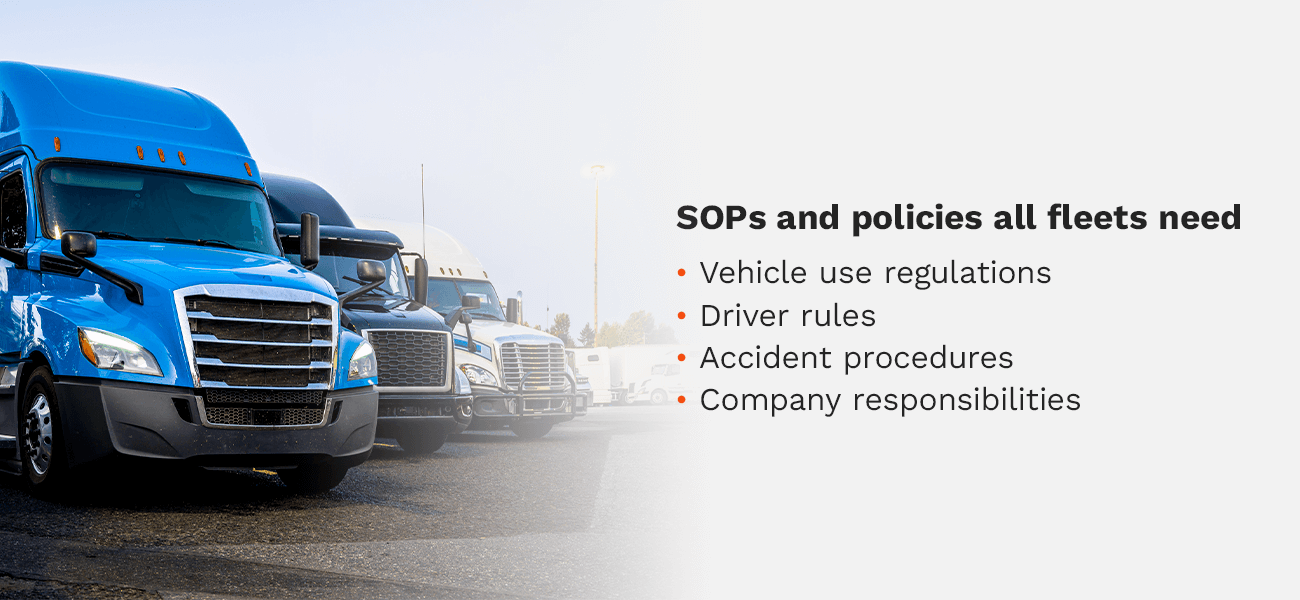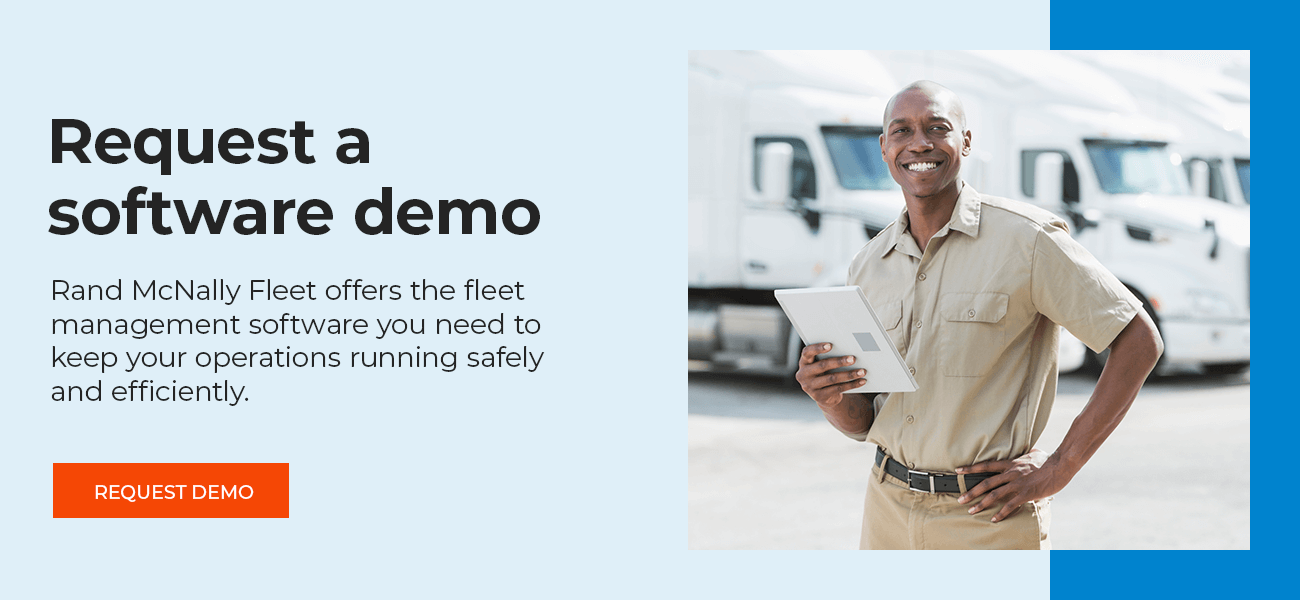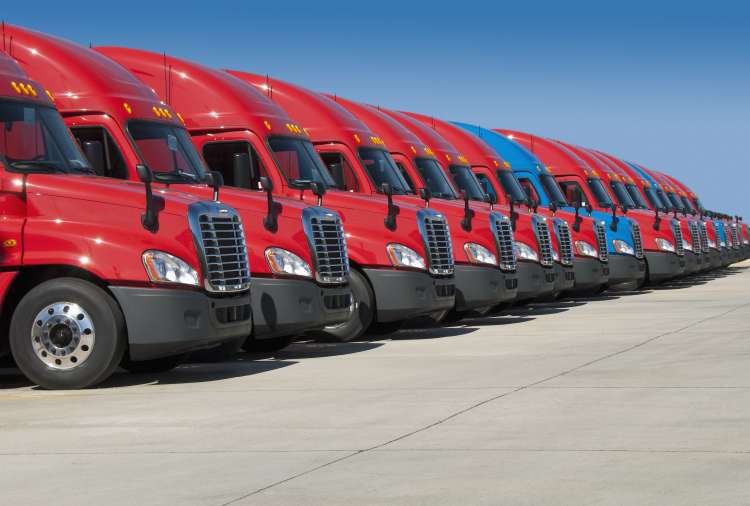SOPs & Policies All Fleets Need
A standard operating procedure, also known as an SOP, is a tool used in a wide range of industries to help create efficiency, high-quality performance, and consistency while lowering the risk of any mistakes and miscommunications.
A good standard operating procedure is a written, step-by-step guide that makes the order of operations as straightforward and easy to understand as possible. It helps establish the expectations an employer may have for an employee regarding any of the tasks they are assigned to perform.
What is an SOP in Fleet Management?
SOPs are essential in the fleet management industry. When working with large equipment such as trucks and other fleet vehicles, it's important to have clear guidelines. Standard operating procedures in fleet management put details in place to clearly define what is expected among employees and what the consequences are when an employee does not meet those expectations.
The majority of SOPs in the fleet management industry revolve around the usage and coverage of all vehicles employees are working around. These procedures are set in place to ensure the safety of all employees.

SOPs and Policies All Fleets Need
Whether you're just starting a small fleet management company or you're working to improve the safety of your large organization, you should have SOPs regarding:
- Vehicle Use Regulations: If a company is providing a vehicle to employees, it's important to set out strict guidelines as to what use of the vehicle is considered acceptable. For example, will the driver be able to take this vehicle out for personal use, or should it only be used for company-related purposes? Make sure expectations are clear.
- Driver Rules: Consider any rules you expect your drivers to follow. How fast can the vehicle travel? Can the driver eat and drink nonalcoholic beverages while operating the vehicle? Can the driver have passengers who are not related to the company in the vehicle with them? Make sure to write out these rules and expectations in detail, leaving no room for misinterpretation. Establish clear consequences for drivers who do not follow the rules.
- Accident Procedures: No matter how careful your drivers are, accidents are bound to occur occasionally. Make sure to clearly define what steps should be taken should an accident occur in an SOP. Write out who the accident should be reported to and what time frame it should be reported in. Explain what kind of information should be gathered at the scene of the accident and what will happen if a crash is deemed preventable. Describe what the consequences will be if an accident occurs due to reckless driving.
- Company Responsibilities: Make sure to clearly define the company’s roles and responsibilities in the fleet management process. Will management be assigning training to all employees? Will they be responsible for the maintenance of the vehicles? Or will the company be hands-off in fleet management? Regardless of the level of involvement, any responsibilities that the company will be handling should be clearly defined by an SOP.
Creating and Implementing Fleet Policies
The process of creating and maintaining an SOP can be broken down into five main steps:
- Research Fleet Standard Operating Procedures: Thorough research is important when it comes to creating a solid SOP. Take time to reach out to others in the fleet management industry to learn what policies and procedures have been helpful to them. Then, talk to your employees and members of the company in other departments to help determine where issues are arising. Ask for input as to how to fix them.
- Define the Purpose of the Fleet Policy: Once you have a list of SOPs that you want to create, it's essential to determine what the ultimate purpose of your policies is. Do you aim to maintain the safety of all employees? Or are you trying to find ways to make the work process more efficient? Regardless of your reasoning, determining the purpose of the policy can help you decide what steps need to be taken.
- Write it Out: Once you have your research and purpose outlined, you can start to write your fleet policies. Determine how you want to communicate your fleet SOPs. You might utilize written policies, reference guides, online training, and video resources. Determine which type of content is most effective and start explaining your policy. Provide as much information and detail as possible while still aiming to be concise. Explain what the policies are and what the consequences will be if the policies are not followed.
- Take Time to Review: Once you're satisfied with your fleet management SOPs, share them for review. Send them to the internal employees who gave you input and ask them if they think these procedures will be effective. Ask them if they have any additional suggestions or data that you could use to back up your policies.
- Update When Meeded: Developing fleet policies for drivers is an ongoing task. You may need to update your SOPs on a regular basis as new technologies and regulations come into play. If you change your policies, make sure to update employees and provide training as needed.
How Fleet Software Helps With Enforcement and Accountability
You can write out detailed fleet SOPs, but how can you be sure that your employees are following the policies as outlined? Fleet software can help with the enforcement and accountability of your SOPs.
You might already be using a GPS tracking system for your fleet drivers. Pairing it with a fleet management tool can provide you with real-time data about your employees’ driving behavior and vehicle statuses.
Checking in on your driver analytics can help with safety issues and improve your bottom line. For example, fleet software can tell you how long a driver is idling their vehicle. It can give you information about fuel consumption. It can even tell you if a driver is speeding on the road or engaging in other unsafe behavior.
You can also utilize fleet software to monitor the performance of your vehicles. Fleet software can provide you with the following information to make sure that your vehicle is running in top shape:
- Fuel rate
- Oil pressure
- Engine speed
- Vehicle speed
- Boost pressure
- Battery voltage
- Gallons per hour
- Coolant pressure
- Average fuel economy
- Lifetime fuel economy
Fleet management software provides you with key information to help you ensure your drivers are following the fleet management SOPs they agreed to.
Request a Software Demo
Rand McNally Fleet offers the fleet management software you need to keep your operations running safely and efficiently. Contact us today to request pricing information or a free demo.

Contact Rand McNally
Request Pricing for Fleet Solutions
We're looking forward to talking with you. Please fill out the form to get started.
Or call us:
+1 (800) 789-6277 (Fleet management, ELD, Asset tracking, Navigation)
+1 (800) 234-4069 x2 (MileMaker/IntelliRoute)
If you are an existing customer and need assistance, please contact your Client Success rep or email fleetsupport@randmcnally.com.
This form is for business-to-business transactions only. It is not for personal consumer use.


